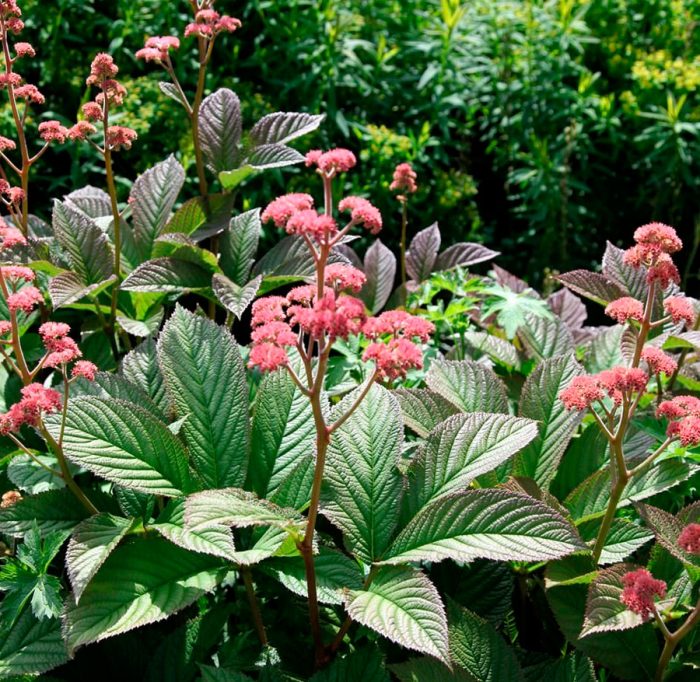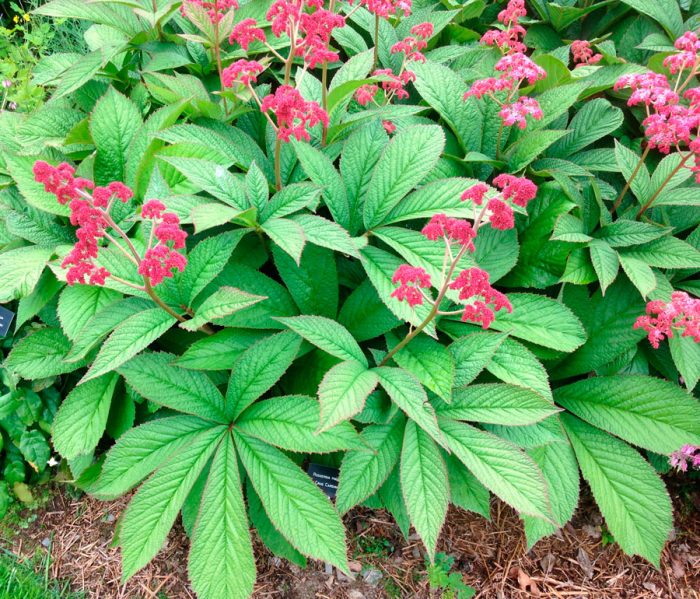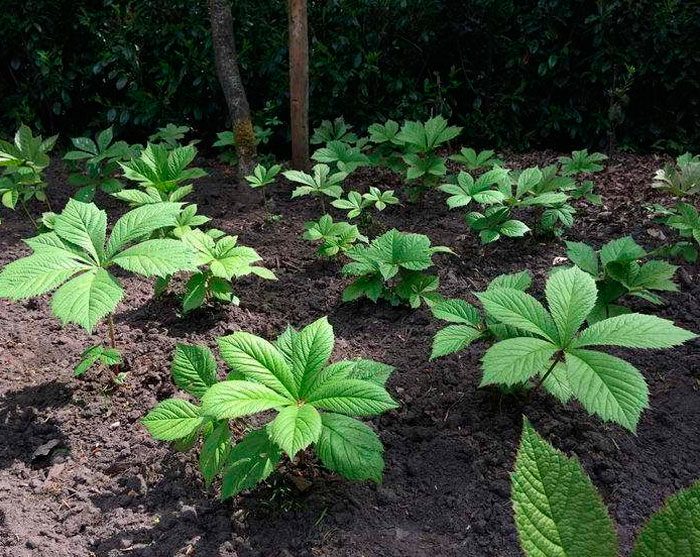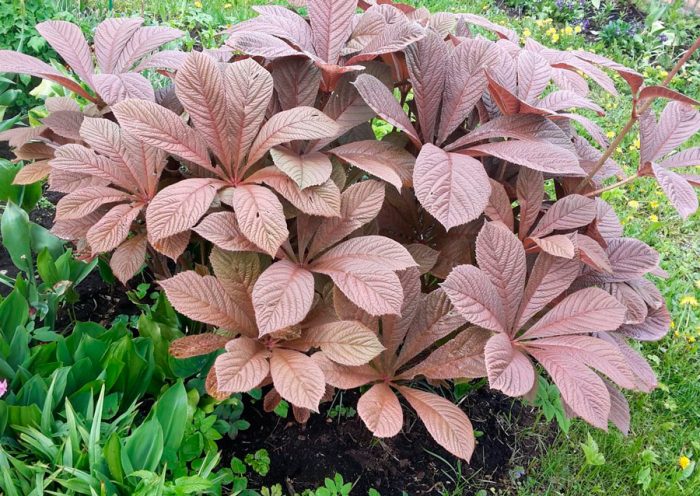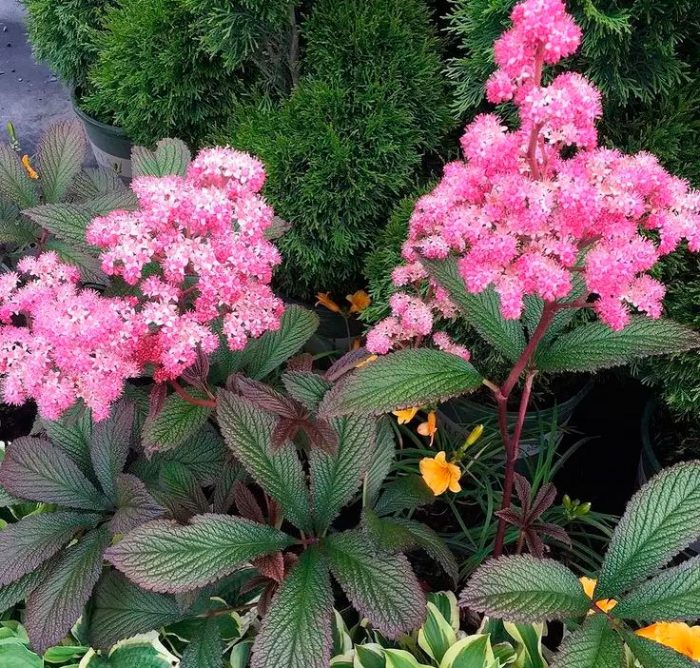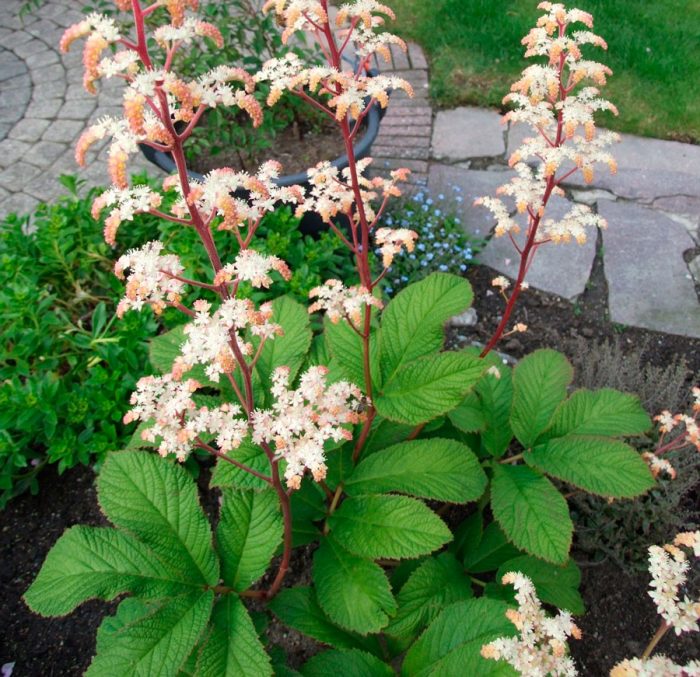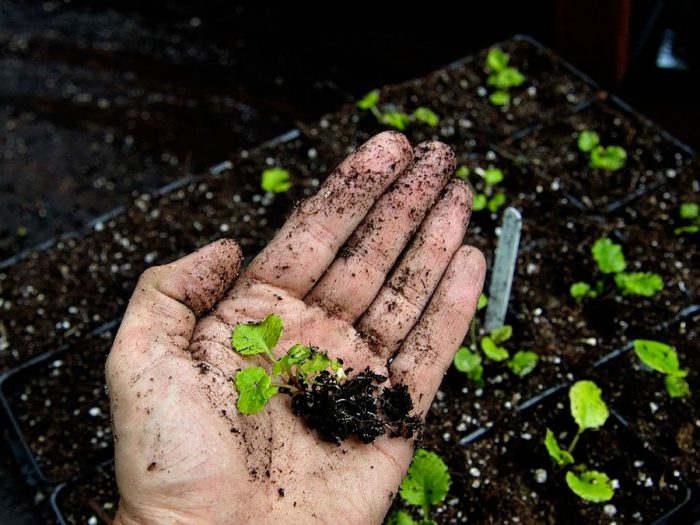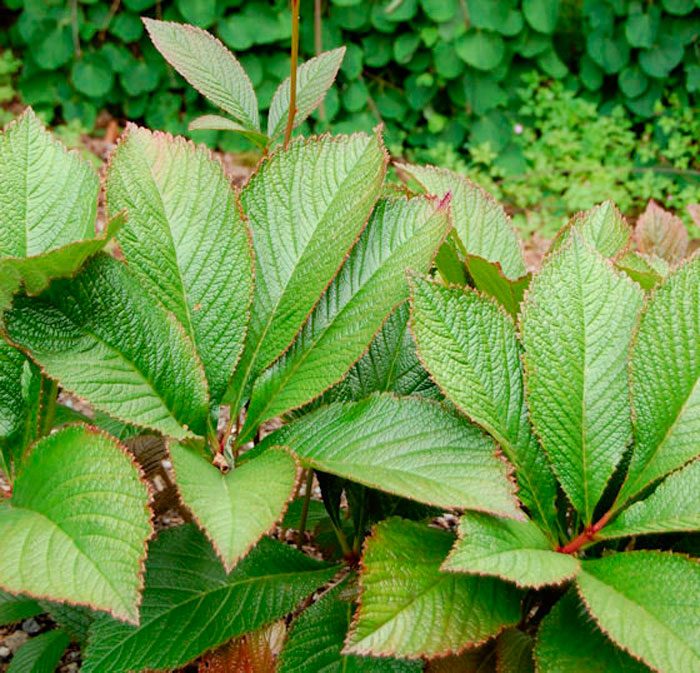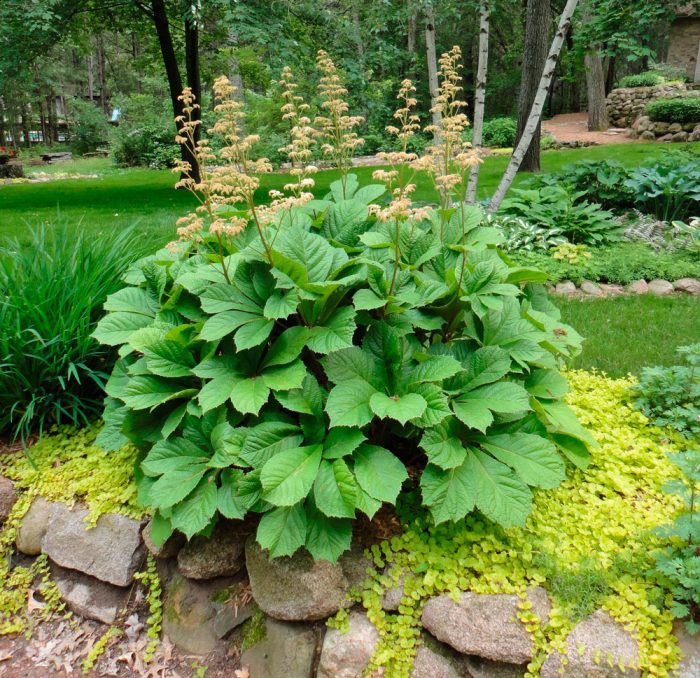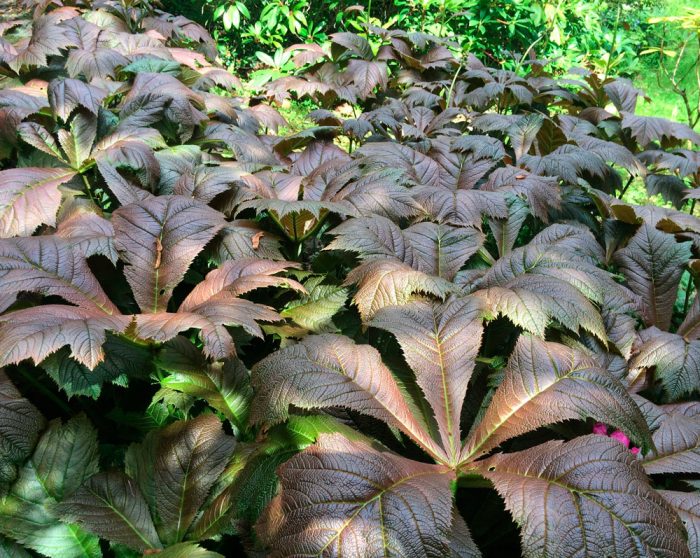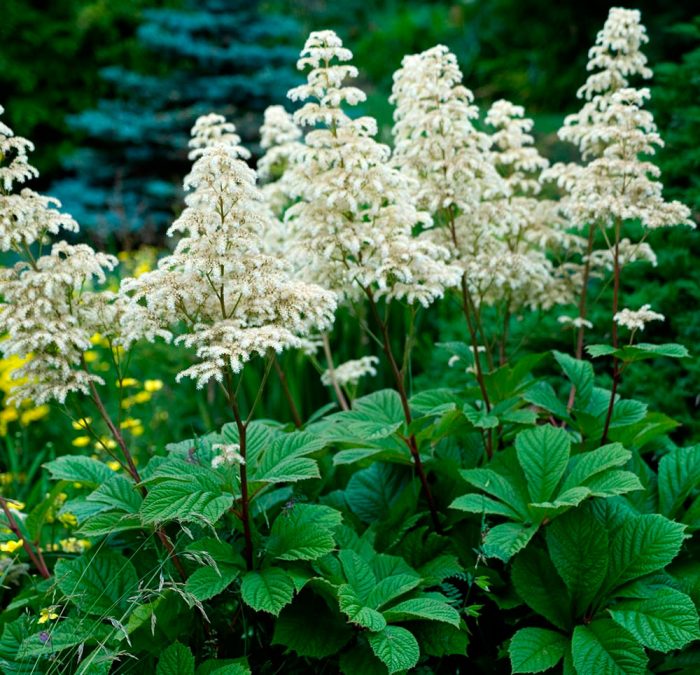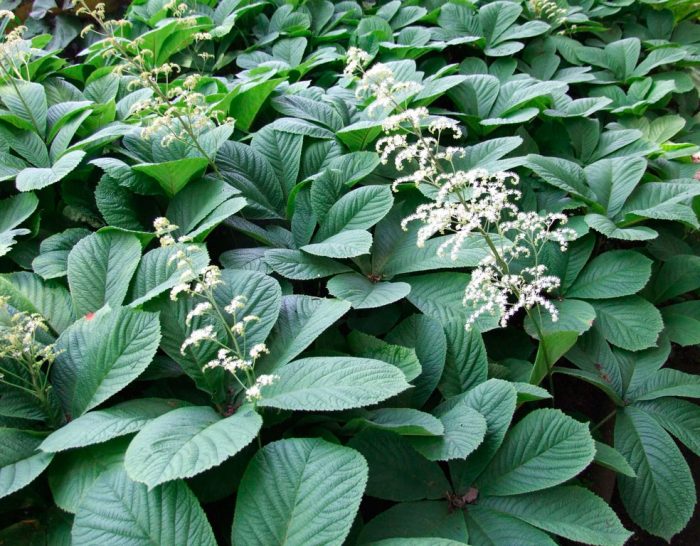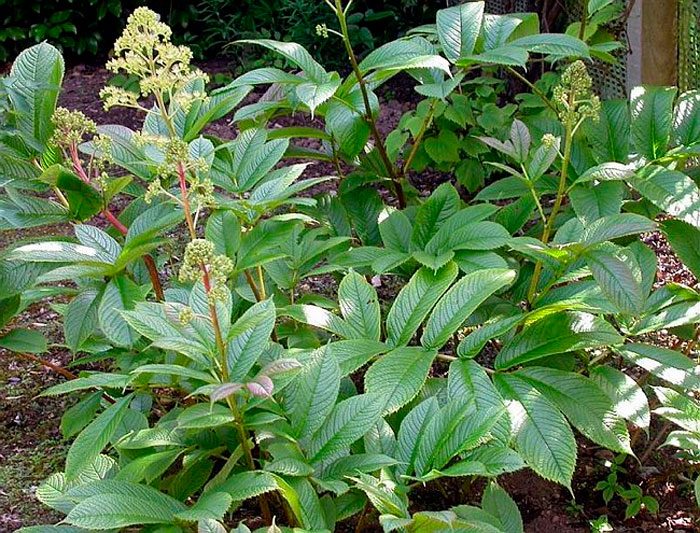If you want to decorate your garden with an unusual exotic plant, then you should pay attention to Rogers. This plant is becoming more and more popular with gardeners every year, but today it is not often seen in gardens.
Such a large-leaved plant is highly decorative and undemanding in care. However, in order for it to develop and grow normally, it requires special growing conditions. If the bush is grown in favorable conditions for it, then it will look very impressive, and will certainly delight the gardener with lush flowering. A powerful rogersia bush, covered with many inflorescences, will look luxurious in any garden. The advantage of this exotic is that it is able to thrive and grow perfectly in places where most other flowers would die, namely: in the full shade of large trees or in the corners between the fence and the building.
Content
Rogers' features
Rogersia is a herbaceous perennial plant. Its root system is pivotal, and it is more developed in young bushes. And in adult and old plants, the rhizome is a modified stem, from which the adventitious roots extend. Thick rhizomes of such a perennial grow directly under the surface of the soil, while they can cover quite large areas. This flower feels best in a shaded area with moist and nutritious soil. It should be remembered that it must be protected from gusts of wind and scorching direct rays of the sun.
Rogers fell in love with gardeners for the fact that it has spectacular foliage. Its leaf plates are very large and highly textured, and can be copper, metallic, bronze or brown. The foliage is attached to powerful stems, and it can be of varying degrees of dissection (depending on the species). This plant looks great in a rocky garden or in a large rockery.
The flowering of such a plant is observed in the middle of the summer period, and it lasts from 4 to 6 weeks.When the bush fades, it begins to intensively grow foliage. During flowering, paniculate inflorescences are formed, consisting of small and fragrant flowers. They can be painted in a variety of colors, from red and pink to yellow and white. This plant is considered an excellent honey plant, and it needs insects for pollination.
Rogersia is part of the Saxifrage family, and this genus is relatively few in number. To date, only 5 species of Rogers and several dozen varieties are known. This plant comes from the Japanese island of Honshu, from the southeastern part of Asia and from Korea. Moreover, some of the species can be found in Tibet, China and Nepal. Powerful stems in height can reach up to 1.5 m, However, this depends on whether Rogersia is grown in favorable conditions, and to which variety it belongs. The dry fruit is a box.
Planting Rogers in open ground
Appropriate place
If you find the most suitable place for the Rogers in your garden, then it can bloom magnificently and delight you with its spectacular leaf plates for at least eight years. The best site for planting such a perennial is considered to be one that is in partial shade and protected from drafts. A suitable substrate should be loose, nutritious and moist. Since this flower is quite picky about growing conditions, when choosing a suitable site for it in your garden, you should consider:
- Well-lit open areas will not work, as the bush will quickly die there.
- This plant has a powerful root system that grows larger every year. Therefore, it is able to displace nearby plants that have a weaker root system.
- The flower needs systematic watering. However, in the event that the groundwater in the area lies quite high, this can lead to stagnation of fluid in the root system, which will cause rot.
- If different species are grown close to each other, they can become over-pollinated. In this regard, during the planting of bushes, a considerable distance is maintained between them.
- This flower grows well in a shady area, as it has the ability to accumulate sunlight. He needs only three hours a day of the diffused light of the sun.
- Low-lying areas are not suitable for growing Rogers. The fact is that melt and rain water accumulates in them, and this becomes the cause of stagnation of liquid in the ground, which can lead to the death of the bush.
Site preparation
For planting Rogers, the soil on the site is prepared in the spring. To do this, dig it up at least 0.3 m in depth, and you need to select all the weeds and roots. During digging, forest and leafy soil is introduced into the soil, as well as organic matter and mineral fertilizers, for example, humus and peat. After that, the site is dug up again. It is recommended to introduce complex mineral fertilizers into the soil, they can also be used to feed the plant throughout the entire growing season. This plant especially needs nitrogen, potassium and phosphorus, as well as the following trace elements: copper, sulfur, iron, zinc, boron, magnesium and molybdenum.
The plant is planted in open ground in spring only after the air temperature at night stays at around 5 to 10 degrees for at least 7 days. The soil on the site should be nutritious, moist and loose. In this case, the plant will look as decorative as possible and bloom profusely.
How to plant in open ground
Rogers can be planted in open ground both in autumn and in spring. Some gardeners prefer to plant this plant in the autumn, since after wintering such a perennial is quickly adopted and begins to grow actively.
When the site is prepared, you can immediately start planting:
- Prepare the landing hole.Its width and length should be slightly larger than the root system of the bush.
- Make a drainage layer at the bottom of the hole to help prevent stagnation of fluid in the root system. You can make a drainage layer from gravel or small stones, and you can also use sand combined with brick chips.
- It is necessary to fill the drainage layer with a thin layer of soil.
- Water the Rogers liberally in the container, in which case it can be easily removed from the container without injuring the root system.
- After a few minutes, remove the bush along with a lump of earth from the container, after which it is placed in the planting hole, while carefully straightening the roots.
- Fill any voids with soil, while compacting it with your hands. Then the bush is watered with well-settled water. To reduce moisture evaporation, cover the soil surface with a layer of mulch, such as peat or crushed bark.
Rogers care
Rogers is capable of growing and developing well even in the area that is in deep shade. Moreover, it will bloom profusely there with fragrant inflorescences. However, without proper and timely care, the plant may die.
How to care for the soil
The root system of such a plant is superficial, so do not forget to carry out a systematic inspection of the soil surface around it. During the entire growing season, the soil surface is regularly and very carefully loosened, while not forgetting to remove weeds. To saturate the soil with oxygen, spud the plant. And to prevent excessive evaporation of moisture, the surface of the soil is covered with a layer of mulch. If you see that the roots are bare, then be sure to sprinkle them with a layer of soil or humus, otherwise they may dry out.
Fertilizer
The fact that organic matter and mineral fertilizers need to be applied to the soil before planting the plant was described above. Also, do not forget to feed the flower with the same fertilizers throughout the entire period of active growth and flowering. To do this, you need to choose fertilizers that contain sulfur, copper, zinc, iron, magnesium and phosphorus.
Watering
Rogersia is a moisture-loving plant, so make sure that the soil on the site does not dry out. In this case, Rogersia will delight you with lush blooms and spectacular foliage. Water the bushes regularly and abundantly, but do not let the liquid stagnate in the soil, otherwise rot may appear on the roots.
Pruning
Timely remove both wilted flower stalks and foliage that has begun to dry out. This will preserve the decorative effect of the bush. Unnecessary foliage, which has dried up or was injured, is cut off with a pruner or knife, and the peduncles are removed only if you do not need seeds.
Transfer
If the site is suitable for growing this perennial, then it can grow in the same place for about 10 years (usually 8). A transplant ahead of time is carried out only when the bush suffers from too intense lighting or if rot appears on the root system due to stagnant liquid in the soil.
Wintering
This thermophilic plant can withstand frosts down to minus 25 degrees. If the bush is properly prepared for winter, then it will be able to winter quite normally in the open field. In late autumn, cut off all the foliage along with the stems almost to the root, and then cover the area with a thick layer of mulch: sawdust, humus, fallen dry leaves or peat. However, if the winter is expected to have little snow, then before filling the area with mulch, it must be covered with a piece of non-woven polypropylene fabric, and its density should be at least 40-60 g / m2... In springtime, the nonwoven fabric will help protect the plant from recurrent frost. Do not cover the bush with a film, as it creates a greenhouse effect, to which the flower reacts extremely negatively.


Watch this video on YouTube
Reproduction methods
Rogersia can be propagated by dividing the bush and by seed.Seed propagation is not very popular, since the seeds of this flower are characterized by low germination. And hybrid varieties, when propagated by seeds, do not retain the varietal characteristics of the parent plant.
Growing from seeds
Start by filling the planting box with moist soil mixture saturated with organic matter and sow the seeds into it. Harvest crops in a place where the air temperature is about 0 degrees, for half a month. Then they are transferred to heat (from 10 to 15 degrees) and high humidity is maintained. After the first seedlings appear, they must be fed. Seedlings that have grown to 10-15 centimeters dive into individual small pots. In the autumn, the seedlings can already be planted in the garden.
If you decide to grow this flower from seed, then remember that only one variety should grow on one site. The fact is that bushes of different varieties are easily pollinated.
Dividing the bush
Divide the bush in the autumn. Remove the horizontal root of the parent bush from the soil and cut it into pieces that are 8 to 10 centimeters long. Treat the delenki with a growth-promoting agent and plant them in a container filled with a substrate of nutritious soil, peat and sand (1: 1: 1). They are buried in the soil by 50–70 mm and transferred to a cool room (from 5 to 10 degrees), where they will stay for about four months until sprouts appear. Plant the sprouts, which are about 50 mm in height, in peat pots, and the plants can be transplanted into the garden in the last days of May or the first days of June.
Cuttings
Cuttings are carried out in the summer. Cut off a few petioled leaf plates and place them in a solution of any growth promoting agent for 12-15 hours. Then the cutting is planted for rooting in a nutritious moist soil mixture.
Disease and pests
Rogersia is resistant to various diseases, but it can still be affected by root rot. It develops due to stagnation of fluid in the roots. In the affected bush, yellowing and wilting of the foliage is observed, and they also darken very quickly. You can help the bush only when the appearance of rot was noticed at an early stage. The bush is dug up, the decayed areas are cut out and planted in another place.
Grape slugs and snails can also harm the flower. They are collected by hand from morning until lunchtime, and then the bush is sprayed with a specialized pesticide.
If the bush is infected with rust fungus, then cut off all diseased foliage and spray the plant with a fungicidal agent. The bush is processed in the daytime, since by the evening its leaves should be dry. If the lighting in the area is excessively intense, then brown specks and dry areas will form on the foliage. Transplant the flower into the shade.
Rogersia in Landscaping
Rogers is very effective even without flowers. It can be grown either singly or in groups. Shady gardens (a section of the garden that is in the shade) are great for her. Such a perennial plant looks great next to a juniper or fern. And it also looks very impressive next to low plants (astilbe, epimedium, ostrich and tiarella), dwarf trees and coniferous shrubs.
Large inflorescences of Rogers can become a bright accent of the entire composition, and daffodils, hosts and irises will look great against the background of thick leaves. It can be grown in flower beds, rockeries, rocky gardens, and this plant is also used for solitary plantings.
Types of Rogers with photos
Today, experts often argue about how many types of Rogers there are. There are 5 described and officially recognized species in total. And they differ in color, shape and structure of leaf plates. Each species has several dozen varieties:
Rogersia stoolis, or podophyllum (Rodgersia podophylla)
Under natural conditions, this species can be found in Korea, China and Japan.The structure of the leaf plate includes from 5 to 7 leaves with large notches at the tips. In spring, during the opening period, the leaves are colored brownish-red. Over time, this shade becomes more bronze. And closer to autumn, the foliage is again painted in the same shade as during the disclosure.
This type of Rogersia is the largest, it can reach a height of up to 1.6 m. During flowering, which begins in the second half of June, branched inflorescences are formed on the bushes, consisting of creamy white flowers.
Rogersia elder (Rodgersia sambucifolia)
This species, which is native to the provinces of China Sichuan and Yunnan, is one of the most common, while it is distinguished by its unpretentiousness. An adult shrub can reach a height of about 0.6 m. Its large leaf plates have a bronze sheen. The foliage of this perennial throughout its life does not change its color and remains green. The number of leaf plates on a bush is influenced by the age of the plant, as well as the growth conditions. Sometimes up to 13 leaf plates can form on one plant. This species blooms in July. Fragrant small flowers are collected in large branched inflorescences. The flowers are painted white, but after a while it changes to greenish brown.
Rogersia pinnata (Rodgersia pinnata)
In this type, leaf plates can have different shapes, in this regard, it is often confused with other types. A characteristic feature of this species are large leaf plates with clearly distinguishable veins, located on the petiole randomly like feathers. Closer to autumn, the color of the foliage changes to a bronze-red. The petioles can be short, thanks to which the bush looks like a palm tree. In July, during flowering, pinkish-white inflorescences form on the plant. This species is the most resistant to drought. The bush can reach a height of about 0.7 m.
A popular variety of this species is Rogersia Chocolate Wings. It blooms from June to September. At the same time, fragrant large racemose inflorescences are outwardly similar to chestnut inflorescences.
Rogersia horse chestnut (Rodgersia aesculifolia)
In nature, this species can be found in China in mountain pine forests, and it is found at an altitude of 2900-3000 meters above sea level. Foliage of this type is outwardly similar to horse chestnut leaves. It does not have petioles, while the color of the leaf plates is greener when compared to other species of Rogers. Flowering begins in June, while pinkish-white or pink flowers are formed on the bush, collected in inflorescences. The bush can reach a height of about 100 cm. It grows well in the shade and in sunny areas, but only if it is watered in a timely manner.
Rogersia nepalensis (Rodgersia nepalensis)
This plant differs from other species in the shape of leaf plates: their petiole is elongated, and jagged edges are also clearly distinguishable. The leaf plates on the stem are located at a great distance from each other and can be colored in various shades of light yellow or greenish-blue. Dense pyramidal inflorescences consist of lemon or greenish flowers. This plant is quite rare in nature, while it is considered one of the most spectacular types of Rogers: the bush is decorated with glossy leaf plates of an unusual shape.
Useful Tips
- When planting, the roots are buried in the soil no more than 60 mm.
- You can mulch the soil with straw or sunflower husks.
- Falling flowers and foliage may be associated with too little watering. Adjust the watering mode.
- In dry hot periods, the bushes are regularly watered, and also moistened with a sprayer (by the evening, the drops on the foliage should dry out).
- Sprinkle the surface of the soil around the bushes with crushed egg shells or wood ash to prevent slugs from reaching them.


Watch this video on YouTube

